

 Vol. 41 (Number 06) Year 2020. Page 30
Vol. 41 (Number 06) Year 2020. Page 30
VOROBYEVA, Inessa Anatolyevna 1
Received: 10/09/2019 • Approved: 25/02/2020 • Published: 27/02/2020
ABSTRACT: The article presents a model of information interaction between the subject of training and an intelligent learning system that helps to create the conditions for the formation of the competencies required for the future professional activity of students. The article examines the theoretical background for the technology of the instructional design of an intelligent learning system that can generate an educational environment that adapts to students’ capabilities in terms of the learning style and rate new educational material and that takes into account the students’ chosen type of professional activity. |
RESUMEN: El artículo presenta un modelo de interacción de información entre el tema de capacitación y un sistema de aprendizaje inteligente que ayuda a crear las condiciones para la formación de las competencias requeridas para la futura actividad profesional de los estudiantes. El artículo examina los antecedentes teóricos para la tecnología del diseño instruccional de un sistema de aprendizaje inteligente que puede generar un ambiente educativo que se adapte a las capacidades de los estudiantes en términos del estilo de aprendizaje y califique el nuevo material educativo y que tenga en cuenta los estudiantes elegidos. tipo de actividad profesional. |
The Law on Education in the Russian Federation prescribes general rules for the education system operation, aimed at “creating conditions for self-fulfillment of each individual” and “freedom of choice to receive an education according to the aptitudes and needs of everyone” (Federal Law No. 273, 2012). In this regard, the higher education standards specify requirements for a learning environment for students with the purpose to execute the government order for university graduates (Federal Standard, 2018). So far, there has been a lot of research in the use of intelligent learning systems. The problems of student adaptation to the use of information and computer technologies were addressed many works (Bespalko, 1995; Krechetnikov, 2002; Okolelov, 1999; Selevko, 1998; Khutorskoy, 2001); the principles of learner-centered and competency-based approach, also applicable in information systems, were considered by Verbitsky and Kruglikov (1998), Shiyanov and Kotova (1999), and other researchers; the conceptual basis for new information technology development was dealt with by Mashbits (1988) and Tikhomirov (1977). Therefore, our first priority is to give a theoretical description of the fundamentals for using intelligent learning systems in the educational process.
The research and practical experience have allowed us to identify the fact that educational institutions do not fully use the whole potential of computer technology in the modern context, despite the fact that intelligent learning systems (ILSs), as one of the stages of software application in training, are adaptable. In the course of the study, it was necessary to theoretically and methodologically substantiate the instructional design of an intelligent teaching system that would generate an adaptive educational environment aiming to enhance common cultural and professional competencies in undergraduate students. The goal of the present study is to theoretically and methodologically substantiate the instructional design of intelligent learning systems aimed at forming undergraduate student competencies.
Most literature sources view e-learning systems as the possibility to use online materials outside the school. Cemile, Nur, and Lakhmi (2008) present an adaptive intellectual learning system that monitors students’ learning process in accordance with their profile, and describe a case study of using this system (Xu, Wang, and Wang, 2005).
Xu, Wang, and Wang (2005) describe a conceptual model of personalized virtual learning environments, which is one of the rapidly evolving areas of educational technology research and development. Mona and Sanaa (2016) describe an intelligent learning system for teaching Arabic grammar, which consists of a training module, a module for selecting questions, an expert module, a student model, and a graphical user interface (Mona et al., 2016). Stellan Ohlsson (1993) describes the possibility of using various gadgets in training. His research shows the extended use of learning programs as mobile applications, which improves student performance.
The methodological framework of the study was composed of the theoretical background and conclusions contained in the fundamental and applied studies of domestic and foreign authors on the data systems engineering (Mashbits, 1988; Tikhomirov, 1977), as well as on the problems of forming professional competencies in students, social design of instructional systems and educational parks management (Verbitsky and Bakshaev, 1988; K.G. Krechetnikov, 2002; Okolelov, 1999; Selevko, 1998; Khutorskoy, 2001). The research is based on the concepts of vocational pedagogy, computer science, and instructional systems design.
The paper uses such research methods as analysis of literature on the problems of vocational education, the use of information technologies in the educational process, analysis and generalization of theoretical principles and conclusions, analysis of documents governing the formation of undergraduate student competencies, questionnaires, testing, etc.
A preliminary experiment was conducted among students majoring in Mathematical Methods in Economics, Applied Information Science in Economics, and Computer Science. The intelligent learning system developed in accordance with theoretical principles and conclusions was used to organize students’ self-directed leaning with a subsequent knowledge assessment. Their knowledge was assessed using the learning system tests.
An intelligent learning system is a computer program consisting of a certain action rule set in this program and rules for educational and assessment content supply (Ding et al., 2016). These rules are subject to requirements for the learning system and take into account the learner’s behavior, their level of earlier and newly acquired competence, and their aptitude to the selected type of professional activity. The actions carried out by the ILS occur according to the rules of expert systems capable of resolving problem situations. Their key feature is the ability to find the optimal solution under given conditions to achieve the best result (Yakhneeva et al., 2020). Thus, ILSs operate according to the principles of expert systems that implement expert action models within a certain knowledge domain, in this case impersonating the teacher, using inference and decision-making procedures and a database comprising information required for forming student competencies and a collection of rules for its inference and updating.
When using the ILS, an individual modular educational path is generated for each student, with specific goals and objectives for the current and subsequent periods. Competencies are formed in accordance with the identified degree of students’ propensity for the chosen type of professional activity (general abilities, elementary special abilities, and vocational abilities), as well as the level of competence available at the time of using the ILS. Each ILS user can opt for a path to study the proposed learning content required to form the selected competencies. The user environment where they carry out their educational activities should provide comfortable conditions, take into account the requirements of engineering psychology and ergonomics, and be easily navigable (Salih, 2019).
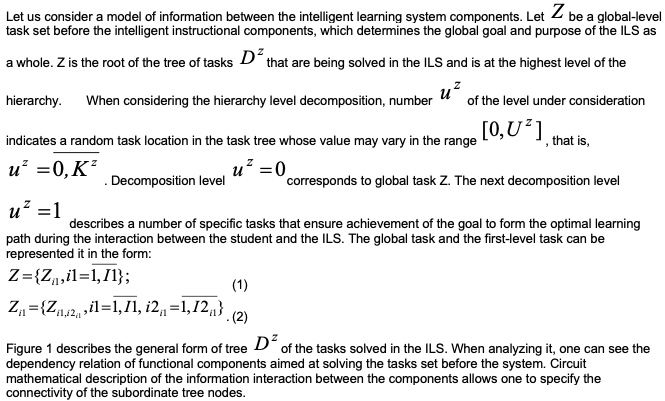
Figure 1
Tree of tasks solved in ILS

Source: compiled by the authors

Figure 2
Information interaction pattern of subordinate
functional components in task solving
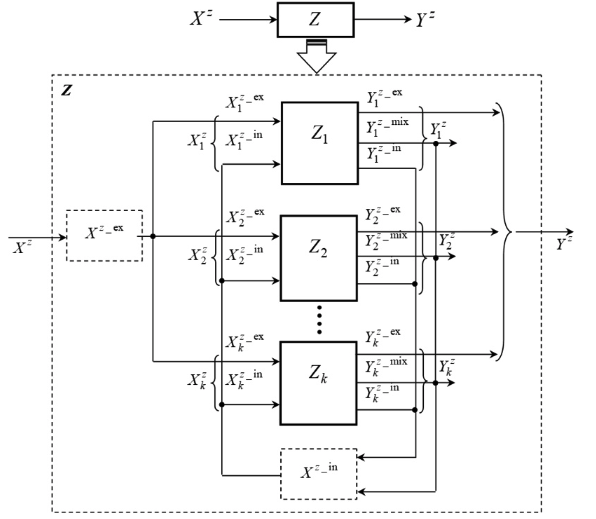
Source: compiled by the authors
Let us provide a mathematical description of connections between the subordinate components, implemented in solving the task to form student competencies Z. To do this, we will sequentially consider the structures of input and output sets and their connection with the global learning task.

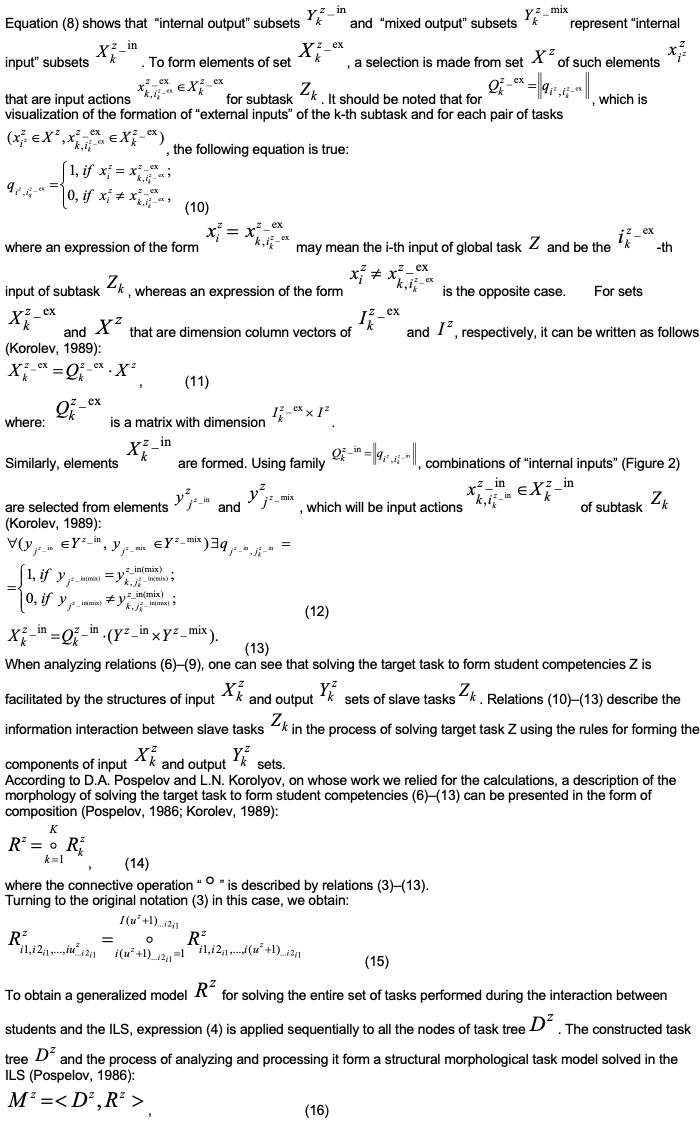

Figure 3
A set-theoretic model of information
interaction of ILS components
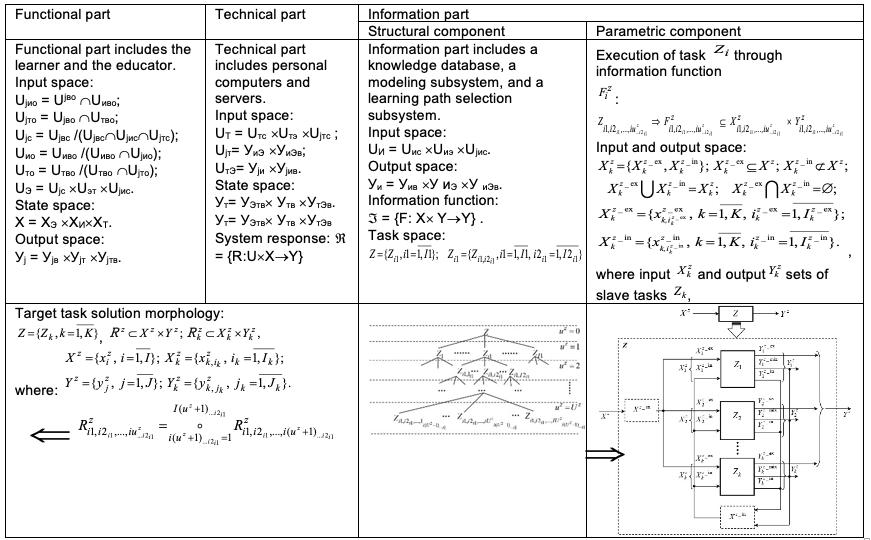
Source: compiled by the authors
As part of the preliminary experiment with second-year students majoring in Mathematical Methods in Economics and Applied Information Science in Economics on the use of ILS for generating an individual educational environment, testing was conducted with the aim of identifying the level of competence in the Numerical Methods discipline after the first month of training. Eighty-eight second-year students were tested, comprising 28 students majoring in Mathematical Methods in Economics, 25 in Applied Information Science in Economics, and 35 in Information Science. The results of testing the students majoring in Mathematical Methods in Economics are presented in Table 1.
Table 1
Results of testing second-year students majoring
in mathematical methods in economics

Let us find the numerical characteristics of the resulting sample. The arithmetic mean is calculated by the formula,

For this purpose, we draw up a calculation table.
Table 2
Sample variance
calculation table
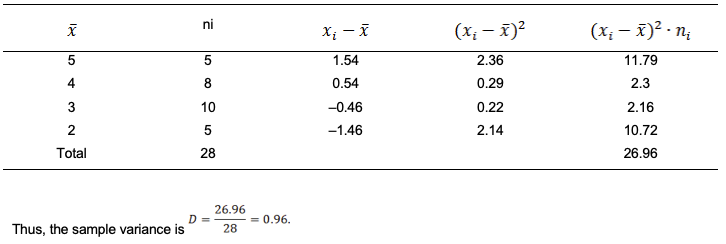
-----
Table 3
Results of testing second-year students majoring
in applied information science in economics


Table 4
Sample variance
calculation table

-----
Table 5
Results of testing second-year students
majoring in information science

-----
Table 6
Sample variance
calculation table



Table 7
Results of final assessment of numerical methods competence of
students majoring in mathematical methods in economics (control group)

-----
Table 8
Sample variance
calculation table

-----
Table 9
Results of final assessment of numerical methods competence of students
majoring in applied information science in economics (experimental group)

-----
Table 10
Sample variance calculation table


The above model of information interaction of the intelligent learning system components aims to solve general and (or) specific tasks arising in ILSs, namely to assess students’ individual abilities and the knowledge acquired, to generate an individual learning path, to form information content from the knowledge database, and to monitor the acquired competencies in real time mode. The tasks are carried out by means of software from among the information support and by implementing the information functions of the intelligent instructional components in the ILS.
I would like to extend my gratitude to my research advisor, Professor at the Department of Preschool and Primary Education of Lipetsk State Pedagogical P. Semenov-Tyan-Shansky University, Mariya Vasilyevna Lazareva for her recommendations on the research and assistance in the manuscript finalization.
Afanasyev, A., & Voyt, N. (2010). Intelligent training system for the conceptual design of automated systems. Bulletin of the Samara Scientific Center of the Russian Academy of Sciences, 12(4-2), 465-468.
Ben-Jacob, M., Levin, D., & Ben-Jacob, T. (2000). Learning Environment in XXI. International Journal of Educational Telecommunications, 6(3), 201-213.
Bespalko, V. (1995). Pedagogy and progressive learning technologies. Moscow.
Brusilovsky, P. (n.d.). Adaptive and Intelligent Technologies for Web-based Education. In C. Rollinger, & C. Peylo, Special Issue on Intelligent Systems and Teleteaching, Konstliche Intelligenz (pp. 19-25).
Brusilovsky, P., Ritter, S., & Schwarz, E. (1997). Distributed intelligent tutoring on the Web. Proceedings of AI-ED’97, 8th World Conference on Artificial Intelligence in Education, 482-489.
Butorin, D. (2007). Intelligent adaptive learning system for distance education. Computer science and education, 10, 126-128.
Cemile, S., Nur, A., & Lakhmi, C. (2008). Intelligent learning system for online learning. International Journal of Hybrid Intelligent Systems - Recent Advances in Intelligent Paradigms Fusion and Their Applications archive, 5(3), 129-141.
Ding, G., Jiang, J., Zhang, H., Ma, X., Li, R., Zou, Y., & Zhang, J. (2016). Development and challenge of digital design of high-speed trains in China. Journal of Southwest Jiaotong University, 51(2), 251-263.
Dolotina, E. (2013). Features of the use of expert systems in intelligent computer-based training systems. Proceedings of the International Symposium Reliability and Quality, 1, 276-278.
Fardinpour, A., Mohsen, P., & Burkle, M. (2014). Intelligent Learning Management Systems: Definition, Features and Measurement of Intelligence. International Journal of Distance Education Technologies, 12(4), 19-31.
Federal Law. (2012). “On education in the Russian Federation”: Federal Law No. 273 as of December 29, 2012. Retrieved from http: //www.rg.ru/2012/12/30/obrazovanie-dok.html
Federal Standard. (2018). The federal state educational standard of higher education – a bachelor's degree in training 44.03.05 Pedagogical education (with two training profiles). Retrieved from http://fgosvo.ru/uploadfiles/FGOS%20VO%203++/Bak/440305_B_3_
Khashbulatova, B. (2016). The principles of building intelligent learning systems. E-learning in continuing education, 1, 957-962.
Khramtsova, E. (2017). Intelligent learning systems. Theory. Practice. Innovation, 12(24), 56-62.
Khutorskoy, A. (2001). Modern didactics: Textbook for universities. St. Petersburg: Piter.
Korolev, L. (1989). Software equipment and decision making issues: Collection of scientific papers. Moscow: Publishing House of Moscow State University.
Krasilnikova, V. (2012). The use of information and communication technologies in education: a training manual. Orenburg: Orenburg State University.
Krechetnikov, K. (2002). Designing a creative educational environment based on information technology at a university. Monograph. Moscow: Goskoor Center.
Kudryashova, E. (2007). The structure of an automated teaching system based on the recommendations of the Bologna conference. Successes in modern science, 7, 115.
Kupeeva, I., Ravodin, R., & Efremov, A. (2015). Intelligent training systems as an element of a system for improving the quality of medical care. Health Protection Manager, 1, 51-56.
Lalov, B. (1982). Didactic basis for the use of automated teaching aids: Abstract of the dissertation of the Candidate of Sciences (Pedagogy). Moscow: MSPI.
Liaudis, V. (1985). Psychological principles of constructing interactive training programs in a situation of computer training. Psychological, pedagogical and psychophysiological problems of computer training. Moscow: Pedagogy.
Lim, W. (2017). Improving student engagement in higher education through mobile-based interactive teaching model using socrative. IEEE, 404-412.
Liu, Y., & Xie, C. (2016). An intelligent learning system for supporting interactive learning through student engagement study. 12th International Conference on Natural Computation, Fuzzy Systems and Knowledge Discovery (ICNCFSKD), 618-623.
Mashbits, E. (1988). Psychological and pedagogical problems of the computerization of education. Moscow: Pedagogy.
Mona, H., & Sanaa, H. (2016). An intelligent tutoring system for teaching the grammar of the Arabic language. Journal of Electrical Systems and Information Technology, 3(2), 282-294.
Obraztsov, P. (2000). Psychological and pedagogical aspects of the development and application in the university of information technology training. Oryol: Oryol State Technical University.
Ohlsson, S. (1993). Constraint-Based Student Modeling. Journal of Artificial Intelligence in Education, 3(4), 429.
Okolelov, O. (1999). Distance Learning. Lipetsk: Publishing House of LSTU.
Pospelov, D. (1986). Situational management. Theory and practice. Moscow: Nauka.
Richardson, J., Morgan, A., & Woodley, A. (1999). Approaches to studying in distance education. Higher Education, 37(1), 23-55.
Salih, S.Q. (2019). A new training method based on black hole algorithm for convolutional neural network. Journal of Southwest Jiaotong University, 54(3). Retrieved from http://jsju.org/index.php/journal/article/view/304
Selevko, T. (1998). Modern educational technology. Moscow: Public Education.
Shaik, M., Al Balushi, M., Omar, A., Singh, A., & Ramaiah, C. (2017). E-learning tools to enhance student learning experience: A practice on control system engineering. Reliability Infocom Technologies and Optimization (Trends and Future Directions) (ICRITO) 2017 6th International Conference, 674-677.
Shiyanov, E., & Kotova, I. (1999). Personality Development in Learning. Moscow: Akademiya.
Stern, M., Woolf, B., & Kuroso, J. (1997). Intelligence on the Web? Proceedings of AI-ED’97, 8th World Conference on Artificial Intelligence in Education, 490-497.
Tikhomirov, O. (1977). Psychological mechanisms of targeting. Moscow: Nauka.
Trembach, V. (2013). Electronic educational systems using intelligent technologies. Open Education, 4.
Verbitsky, A., & Bakshaev, N. (1998). The development of motivation in intensive learning. Alma Mater, 1-2, 47-50.
Verbitsky, A., & Kruglikov, V. (1998). Contextual education: the formation of motivation. Higher education in Russia, 1, 101-107.
Xu, D., Wang, H., & Wang, M. (2005). A conceptual model of personalized virtual learning environments. Expert Systems with Applications: An International Journal, 29(3), 525-534.
Yakhneeva, I.V., Agafonova, A.N., Fedorenko, R.V., Shvetsova, E.V., & Filatova, D.V. (2020). On collaborations between software producer and customer: A kind of two-player strategic game. Advances in Intelligent Systems and Computing, 908, 570-580.
1. Institute of Natural Mathematical and Engineering Sciences, Department of Mathematics and Physics, Lipetsk State Pedagogical P. Semenov-Tyan-Shansky University, Lipetsk, Russia. Contact e-mail: inessa.vorobyeva@yandex.ru
[Index]
revistaespacios.com

This work is under a Creative Commons Attribution-
NonCommercial 4.0 International License